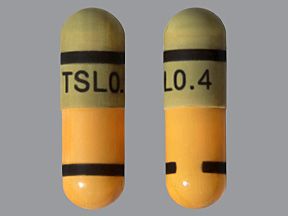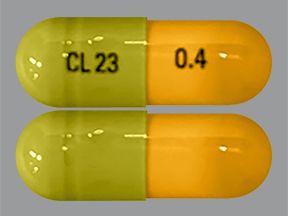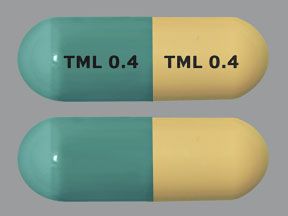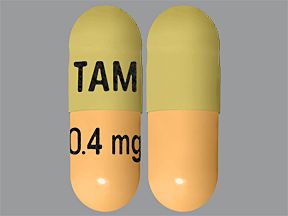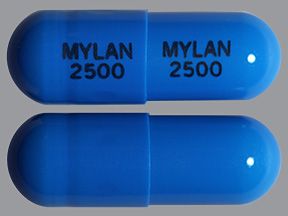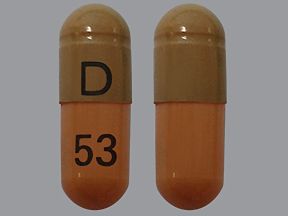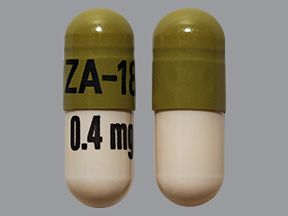If you’ve been diagnosed with benign prostatic hyperplasia (BPH), your doctor may prescribe tamsulosin for you.
BPH is also called enlarged prostate. It’s a noncancerous condition that affects adult males.*
Tamsulosin is used to treat symptoms of BPH. It’s not used to treat high blood pressure, as are other drugs that belong to this group of medications.
* In this article, we use the term “male” to refer to someone’s sex assigned at birth. For information about the difference between sex and gender, see this article.
Tamsulosin oral capsules basics
Tamsulosin hydrochloride is the active ingredient in tamsulosin. It’s a generic drug that comes as oral capsules that you’ll swallow.
This drug is classified as an alpha-adrenergic blocker, which is also sometimes called an alpha-blocker. A class of drugs is a group of medications that work similarly.
Read on to learn more about tamsulosin’s uses, side effects, interactions, and more.
Tamsulosin oral capsules brand-name versions
Tamsulosin oral capsules are available as the brand-name drug Flomax. To learn about this medication, talk with your doctor or pharmacist.
Tamsulosin oral capsules are a generic drug, which means they’re an exact copy of the active drug in a brand-name medication. The brand-name medication that tamsulosin oral capsules are based on is called Flomax.
Generic drugs are thought to be as safe and effective as the brand-name drug they’re based on. In general, generics usually cost less than brand-name drugs.
If you’d like to know more about using Flomax instead of tamsulosin oral capsules, talk with your doctor. And view this Healthline article to learn more about the differences between generic and brand-name drugs.
Like most drugs, tamsulosin oral capsules may cause mild or serious side effects. The lists below describe some of the more common side effects they may cause. These lists don’t include all possible side effects.
Keep in mind that side effects of a drug can depend on:
- your age
- other health conditions you have
- other medications you may be taking
Your doctor or pharmacist can tell you more about the potential side effects of tamsulosin oral capsules. They can also suggest ways to help reduce side effects.
Mild side effects
Here’s a list of some of the mild side effects that tamsulosin oral capsules can cause. To learn about other mild side effects, talk with your doctor or pharmacist, or read the drug’s prescribing information.
Mild side effects of tamsulosin oral capsules that have been reported include:
Mild side effects of many drugs may go away within a few days or a couple of weeks. But if they become bothersome, talk with your doctor or pharmacist.
Serious side effects
Serious side effects from tamsulosin oral capsules can occur, but they aren’t common. If you have serious side effects, call your doctor right away. However, if you think you’re having a medical emergency, you should call 911 or your local emergency number.
Serious side effects of tamsulosin oral capsules that have been reported include:
- infection, which may cause flu-like symptoms
- vision problems
- priapism (long-lasting and sometimes painful erection)*
- problems with ejaculation*
- orthostatic hypotension (low blood pressure when you stand up)*
- chest pain*
- allergic reaction*
* For more information about this side effect, see the “Side effect focus” section below.
Side effect focus
Learn more about some of the side effects tamsulosin oral capsules may cause.
Sexual side effects, including problems with ejaculation
Tamsulosin can
- problems with ejaculation and libido
- priapism (a long-lasting and sometimes painful erection)
- erectile dysfunction (ED)
Tamsulosin isn’t used to treat sexual problems such as ED. Instead, these are possible side effects of the drug.
What might help
If you have sexual side effects with tamsulosin, do not stop taking the drug. Instead, talk with your doctor about your concerns.
They can tell you how to manage the side effects. If your side effects are serious or bothersome, your doctor may switch you to a treatment other than tamsulosin.
Blood pressure change called orthostatic hypotension
Tamsulosin can cause a drop in your blood pressure, especially when you’re changing positions. This could include sitting or standing up from a lying position. This condition is called orthostatic hypotension.
Symptoms of orthostatic hypotension include:
- dizziness
- fainting
- feeling lightheaded
What might help
If you have low blood pressure or you’re taking any medications that can cause it, talk with your doctor before starting tamsulosin. Taking other drugs that can also lower blood pressure can worsen this side effect with tamsulosin.
When you first start taking this drug, be careful when changing positions until you’re used to the drug. And avoid tasks such as driving or operating machinery until you know how tamsulosin affects you.
Ask your doctor or pharmacist for ideas on how to manage low blood pressure symptoms while you’re taking tamsulosin. If you have blood pressure changes that are severe or bothersome, your doctor may have you stop taking tamsulosin.
Chest pain
Tamsulosin may cause chest pain.
If you have serious heart problems, your risk for chest pain with this drug may be increased. Examples of serious heart problems include irregular heart rhythm and fast heart rate.
What might help
If you have chest pain with tamsulosin, call your doctor right away. Or if your pain is severe, go to the nearest emergency room immediately or call 911 or your local emergency number.
Getting prompt medical care is important to help you avoid serious complications from chest pain with tamsulosin.
Be sure to tell your doctor your medical history, including whether you’ve ever had heart problems or chest pain. Also tell them about any medications you’re taking for heart-related problems.
Allergic reactionSome people may have an allergic reaction to tamsulosin oral capsules.
Symptoms of a mild allergic reaction can include:
- skin rash
- itchiness
- flushing (temporary warmth, redness, or deepening of skin color)
A more severe allergic reaction is rare but possible. Symptoms of a severe allergic reaction can include swelling under your skin, typically in your eyelids, lips, hands, or feet. They can also include swelling of your tongue, mouth, or throat, which can cause trouble breathing.
Call your doctor right away if you have an allergic reaction to tamsulosin oral capsules. But if you think you’re having a medical emergency, call 911 or your local emergency number.
Find answers to some commonly asked questions about tamsulosin oral capsules.
Does tamsulosin treat kidney stones or blood pressure problems?
No, tamsulosin is only approved to treat symptoms of benign prostatic hyperplasia (BPH). BPH is also called enlarged prostate. It’s a noncancerous condition that affects adult males.*
Tamsulosin isn’t used to treat high blood pressure, as are other drugs that belong to this group of medications. There’s not enough information known about the safety and effectiveness of using tamsulosin for blood pressure. But the drug can cause low blood pressure as a side effect, especially when it’s first started.
Doctors may prescribe tamsulosin off-label for certain conditions, such as kidney stones. (This is when a drug is used for a purpose other than its approved uses.) A 2018
If you have questions about tamsulosin’s uses, ask your doctor for more information.
* In this article, we use the term “male” to refer to someone’s sex assigned at birth. For information about the difference between sex and gender, see this article.
Is tamsulosin used in females?
Tamsulosin is only approved to treat symptoms of benign prostatic hyperplasia (BPH) in adult males.* BPH is also called enlarged prostate.
This drug may be prescribed off-label for other uses, such as treating lower urinary tract symptoms (LUTS) in females.* (This is when a drug is used for a purpose other than its approved uses.)
LUTS refers to a group of symptoms that can cause problems with your urinary tract and sexual organs. LUTS may cause symptoms such as:
- problems emptying your bladder completely or needing to urinate more often than usual
- trouble urinating or having pain with urination
- pain with sex
- decreased or absent sex drive
A 2017 review
If you have more questions about using tamsulosin in females, talk with your doctor.
* In this article, we use the terms “male” and “female” to refer to someone’s sex assigned at birth. For information about the difference between sex and gender, see this article.
What should I know about tamsulosin’s alternatives, such as alfuzosin, terazosin, doxazosin, and finasteride?
Several other treatment options are available for benign prostatic hyperplasia (BPH), which tamsulosin is used to treat. These options include alpha-blockers other than tamsulosin, such as:
Alpha-blockers work by widening blood vessels and relaxing muscles in the prostate and bladder.
These drugs have some similar uses, side effects, and interactions. But the drugs have some differences, too. For instance, they all come in different strengths and have different active ingredients. Unlike tamsulosin, some alpha-blockers also treat high blood pressure.
Finasteride, which belongs to another group of drugs called 5 alpha-reductase inhibitors, is also used to treat BPH. It is available as the brand-name drugs Proscar and Propecia. Finasteride works by lowering the level of a certain hormone called dihydrotestosterone.
All of the drugs mentioned can cause some sexual side effects, such as ejaculation problems and low sex drive.
To learn more about how these drugs compare, talk with your doctor. They can tell you more about the effectiveness of each in treating BPH.
Does tamsulosin cause side effects in older people or any long-term side effects?
Maybe. Some older adults may have problems with their kidneys or other serious health conditions.
In some cases, serious kidney problems can slow the removal of tamsulosin from the body. This can cause more side effects from the drug, such as dizziness and low blood pressure. Also, if other medications are needed for health conditions, the risk of side effects and drug interactions is increased.
It’s unclear if tamsulosin causes long-term side effects. More studies are needed to learn about possible risks of long-term use.
Tell your doctor if you have any health conditions or are taking other drugs. Your doctor can recommend if it’s safe for you to begin tamsulosin treatment. They may lower your dose of tamsulosin or recommend other options based on your health and how your body responds to tamsulosin.
How does tamsulosin work?
Tamsulosin is used to treat symptoms of benign prostatic hyperplasia (BPH). BPH is also called enlarged prostate. It can cause problems with urination.
Tamsulosin is an alpha-adrenergic blocker, which is also sometimes called an alpha-blocker. It works by blocking the effects of norepinephrine on alpha-1 receptors (attachment sites).
This helps lower blood pressure and relaxes smooth muscles in the prostate, helping to improve urine flow. This is the drug’s mechanism of action.
If you have more questions about how tamsulosin works, ask your doctor or pharmacist.
Can you stop taking tamsulosin? How do you safely stop using it?
Yes, you can stop taking this drug if your doctor recommends. But do not stop taking it on your own.
If you have concerns about how tamsulosin is working or its side effects, talk with your doctor. They can help you safely stop taking the drug and discuss other treatment options with you.
Keep in mind that suddenly stopping tamsulosin may worsen symptoms of your condition.
If you’ve been diagnosed with benign prostatic hyperplasia (BPH), your doctor may prescribe tamsulosin for you.
BPH is also called enlarged prostate. It’s a noncancerous condition that affects adult males.*
Tamsulosin is used to treat symptoms of BPH. It’s not used to treat high blood pressure, as are other drugs that belong to this group of medications.
With BPH, your urethra is blocked, causing problems with urination. Symptoms of BPH can include:
- increased urinary frequency
- urinary urgency
- trouble emptying your bladder
Your doctor may prescribe tamsulosin off-label for other uses. With off-label use, a drug is used for purposes other than approved uses.
Tamsulosin works to relieve symptoms of BPH by relaxing smooth muscles in the prostate and bladder.
* In this article, we use the term “male” to refer to someone’s sex assigned at birth. For information about the difference between sex and gender, see this article.
Your doctor will explain how you should take tamsulosin oral capsules. They’ll also explain how much to take and how often. Be sure to follow your doctor’s instructions.
Below are commonly used dosages, but always take the dosage your doctor prescribes.
Taking tamsulosin oral capsules
Tamsulosin comes as oral capsules that you’ll swallow.
It’s available in only one strength: 0.4 milligrams (mg).
Dosage
You’ll take tamsulosin once each day, at the same time every day.
Your doctor will start you on the lowest dose of tamsulosin. They may increase your dose if your symptoms don’t improve after 2 to 4 weeks of treatment. The maximum dose of this drug is 0.8 mg daily.
Your doctor will let you know the best time of day to take the drug, such as taking tamsulosin in the morning or at night. This can depend on:
- your condition
- other drugs you’re taking
- side effects, such as dizziness or low blood pressure
If you’re more active during the day, taking the drug at night with an evening meal may be a better option for you. Your doctor will discuss when it’s best for you to take tamsulosin.
Taking tamsulosin oral capsules with other drugs
Your doctor may prescribe tamsulosin together with other medications to manage benign prostatic hyperplasia (BPH). Whether you’ll take other drugs with tamsulosin depends on:
- the size of your prostate
- your age and overall health
- other conditions you may have
- how well tamsulosin is working
Your doctor may have you take two different types of BPH medications if one isn’t working well for you. For example, they may prescribe both tamsulosin and a drug that works differently.
Examples of other drugs that may be used with tamsulosin include:
- finasteride
- dutasteride (Avodart)
- dutasteride and tamsulosin (Jalyn)
Your doctor can provide more information on all treatment options for BPH. Be sure to tell them about all your health conditions and all the medications you’re currently taking.
Questions about taking tamsulosin oral capsules
Here are answers to a few questions related to taking tamsulosin oral capsules.
- What if I miss a dose of tamsulosin oral capsules? If you accidentally miss your usual tamsulosin dose, take it as soon as you remember. But if it’s almost time for your next dose, skip the missed dose and continue with your regular schedule. Do not double up on your dose of tamsulosin. If you miss several doses of tamsulosin, call your doctor. They’ll recommend what you should do.
- Will I need to use tamsulosin oral capsules long term? Maybe. It depends on how well the drug is working for you. Your doctor will monitor your symptoms to know this. They may have you take tamsulosin long term if it’s working well.
- Can tamsulosin oral capsules be chewed, crushed, or split? No, do not cut, chew, or crush tamsulosin capsules. Doing so can affect how the drug works. If you have trouble swallowing pills, ask your pharmacist about suggestions to help. You can also consider these tips for swallowing pills.
- Should I take tamsulosin oral capsules with food? Yes, it’s best to take tamsulosin 30 minutes after the same meal every day. For instance, you could take it shortly after your morning meal each day. It’s best to take the drug after the same meal each day, so you can remember to take your doses.
- How long do tamsulosin oral capsules take to work? It may take 2 to 4 weeks for your symptoms to ease with tamsulosin. Your doctor will monitor you when you start taking the drug. They may adjust your dosage or make other changes to your treatment plan if tamsulosin isn’t working for you after a few weeks.
Questions for your doctorYou may have questions about tamsulosin oral capsules and your treatment plan. It’s important to discuss all your concerns with your doctor.
Here are a few tips that might help guide your discussion:
- Before your appointment, write down questions such as:
- How will tamsulosin oral capsules affect my body, mood, or lifestyle?
- Bring someone with you to your appointment if doing so will help you feel more comfortable.
- If you don’t understand something related to your condition or treatment, ask your doctor to explain it to you.
Remember, your doctor and other healthcare professionals are available to help you. And they want you to get the best care possible. So don’t be afraid to ask questions or offer feedback on your treatment.
There are some important things you should discuss with your doctor before starting tamsulosin. These considerations are described below.
Interactions
Taking medications, vaccines, foods, and other things with a certain drug can affect how the drug works. These effects are called interactions.
Before taking tamsulosin oral capsules, be sure to tell your doctor about all medications you take, including prescription and over-the-counter types. Also describe any vitamins, herbs, or supplements you use. Your doctor or pharmacist can tell you about any interactions these items may cause with tamsulosin oral capsules.
Interactions with drugs or supplements
Tamsulosin oral capsules can interact with several types of drugs. Taking these drugs with tamsulosin may increase your risk for some side effects.
Examples of drugs that can interact with tamsulosin include:
- the antidepressant paroxetine (Paxil)
- antifungal drugs such as ketoconazole and terbinafine
- the antibiotic erythromycin
- the stomach acid blocker cimetidine
- erectile dysfunction drugs such as sildenafil (Viagra), vardenafil, and tadalafil
- drugs for benign prostatic hyperplasia (BPH) other than tamsulosin, such as alfuzosin
- alpha-blocker drugs, other than tamsulosin, such as doxazosin and prazosin
- the HIV drugs ritonavir, saquinavir, and indinavir
- the supplements quercetin and saw palmetto
This list does not contain all types of drugs that may interact with tamsulosin oral capsules. Your doctor or pharmacist can tell you more about these interactions and any others that may occur with use of tamsulosin oral capsules.
Warnings
Tamsulosin oral capsules may not be right for you or contraindicated if you have certain medical conditions or other factors that affect your health. Talk with your doctor about your health history before you take tamsulosin oral capsules. Factors to consider include those in the list below.
- Severe kidney or liver problems. Your kidneys and liver clear tamsulosin from your body after you take a dose. If you have severe kidney or liver problems, your body might not be able to properly clear the drug. This can cause levels of it to build up, increasing your risk for side effects. If you have kidney or liver problems, your doctor will recommend if tamsulosin is safe for you to take. People with mild or moderate kidney or liver problems are usually able to take this drug.
- Sulfa allergy. If you’re allergic to sulfa drugs, you may not be able to take tamsulosin. In rare cases, you may have a severe allergic reaction that’s life threatening. Your doctor can give you more information about the safety of tamsulosin use if you have a sulfa allergy.
- Allergic reaction. If you’ve had an allergic reaction to tamsulosin or any of its ingredients, tamsulosin oral capsules are contraindicated for you. You should not take tamsulosin oral capsules, because doing so could put you at serious risk for harmful side effects. Ask your doctor what other medications are better options for you.
- Low blood pressure. Tamsulosin can cause orthostatic hypotension, which is a drop in your blood pressure that happens when you change positions. This can cause dizziness, fainting, and lightheadedness. If you already have low blood pressure, you may have a higher risk for this side effect with tamsulosin. This effect is more likely during the first few weeks of tamsulosin treatment or whenever your dose of the drug is changed. Your doctor can provide more information about this side effect and how to manage it.
- Planned cataract or glaucoma surgery. If you’re planning to have surgery for cataracts or glaucoma, taking tamsulosin can increase certain risks related to the surgeries. The drug can increase risks both during and after surgery. You may also have a higher risk for these problems if you’ve taken tamsulosin in the past, even if you’re no longer taking it. Check with your doctor and eye doctor before having any eye surgeries. If you have a surgery planned, your doctor will likely have you wait to start tamsulosin until sometime after your surgery.
- Prostate cancer. Before you start treatment with tamsulosin, your doctor will check to see if you have prostate cancer. They’ll also routinely monitor you for signs of prostate cancer during your treatment with tamsulosin.
Tamsulosin and alcohol
Taking tamsulosin and drinking alcohol can increase side effects from the drug. Consuming alcohol with alpha-blockers, such as tamsulosin, can
- low blood pressure
- dizziness
- fainting
Your doctor will be able to give you more information about drinking alcohol while you’re taking tamsulosin.
Pregnancy and breastfeeding
Tamsulosin is only approved for use in adult males.* There’s no information available about possible risks if tamsulosin is taken during pregnancy. It’s also not known what nursing implications the drug may have if it’s taken while breastfeeding.
Talk with your doctor if you’d like more information about tamsulosin use during pregnancy or while breastfeeding.
* In this article, we use the term “male” to refer to someone’s sex assigned at birth. For information about the difference between sex and gender, see this article.
Do not take more tamsulosin oral capsules than your doctor prescribes. Using more than this can lead to serious side effects.
Symptoms of overdose
Symptoms caused by a tamsulosin overdose can include very low blood pressure.
What to do in case you take too much tamsulosin
Call your doctor if you think you’ve taken too much tamsulosin. You can also call 800-222-1222 to reach the American Association of Poison Control Centers, or use its online resource. However, if you have severe symptoms, immediately call 911 (or your local emergency number) or go to the nearest emergency room.
Costs of prescription drugs can vary depending on many factors. These factors include what your insurance plan covers and which pharmacy you use.
Financial assistance to help you pay for tamsulosin oral capsules may be available. Medicine Assistance Tool and NeedyMeds are two websites that provide resources to help reduce the cost of tamsulosin oral capsules.
These websites also offer tools to help you find low-cost healthcare and certain educational resources. To learn more, visit their websites.
If you’ve been diagnosed with benign prostatic hyperplasia (BPH), your doctor may prescribe tamsulosin for you. To learn more about BPH, see the “What are tamsulosin oral capsules used for?” section above.
There are quite a few medications available to treat BPH. Ask your doctor about the risks and benefits of using tamsulosin. Here are a few questions you might consider asking:
- Does tamsulosin cause constipation?
- Is tamsulosin a diuretic (water pill)?
- Will my BPH worsen if I stop taking tamsulosin?
- What happens if tamsulosin doesn’t work for me?
You can read about treatment options for BPH here. Additionally, here’s more information about drug treatment for BPH and alternatives to tamsulosin (Flomax).
Q:
Can I drink fruit juices, such as grapefruit juice, with tamsulosin?
Anonymous patientA:
It’s best to avoid drinking grapefruit juice while you’re taking tamsulosin, unless your doctor specifically says you can.
Grapefruit juice contains things that can slow your body’s ability to clear tamsulosin after you take a dose. This can cause levels of the drug to build up in your body, increasing your risk for side effects.
If you drink grapefruit juice, be sure to tell your doctor before you start taking tamsulosin. They may recommend that another medication would be safer for you.
If you have questions about drinking other fruit juices during treatment, check with your doctor or pharmacist.
Disclaimer: Healthline has made every effort to make certain that all information is factually correct, comprehensive, and up to date. However, this article should not be used as a substitute for the knowledge and expertise of a licensed healthcare professional. You should always consult your doctor or another healthcare professional before taking any medication. The drug information contained herein is subject to change and is not intended to cover all possible uses, directions, precautions, warnings, drug interactions, allergic reactions, or adverse effects. The absence of warnings or other information for a given drug does not indicate that the drug or drug combination is safe, effective, or appropriate for all patients or all specific uses.

